Tribolumen: A Tribometer for A Correlation Between AE Signals and Observation of Tribological Process in Real-Time—Application to A Dry Steel/Glass Reciprocating Sliding Contact
Abstract
1. Introduction
2. Materials and Methods
2.1. Tribolumen
- An electrodynamic shaker (LDS—V406/8™) generating a reciprocating motion with a controlled displacement amplitude and frequency. The maximum tangential force delivered was about 100 N.
- A moving unit with a flat specimen holder.
- An upper lever arm with a ball holder allowing the application of the load.
- A force sensor located at the outlet of the shaker and in contact with the platform allowing the measurement of the actuator force Fa.
- A force sensor fixed on the upper arm for the tangential force measurement FT.
- A magnetic contactless sensor for the contact displacement measurement δi.
2.2. Acoustic Emission (AE) System
2.3. Experimental Conditions
- A ball-on-flat steel/glass contact where the ball was 100Cr6 steel with a diameter of 6 mm.
- A constant normal load of 5 N applied on glass flat. This load corresponded to a maximum contact pressure of 700 MPa and a contact radius of 58 µm.
- A linear sweep of the oscillating frequency from 5 to 50 Hz with a constant increment of 0.25 Hz/s.
- An amplitude of displacement of ±100 µm (i.e., a stroke distance of 200 µm), which corresponded to an alternative friction, closet to fretting conditions and an amplitude of displacement of ±50 µm corresponding to fretting conditions.
- A high-speed camera JAI GO-5100C-USB was positioned on the transparent sample side and passed through the support bloc. The maximum resolution of this camera was about 2464 (H) × 2056 (V) with a pixel size of 3.45 µm and a maximum frame rate of 74 Hz. The camera was set at 1000 pixels × 1056 pixels using a frame rate of 180 fps.
- An optical fiber fixed on the optical system was used to illuminate the contact area between steel ball and glass sample. A modular zoom lenses (magnification × 12) that could be configured to fit nearly the contact area is fixed on the camera. Adapter tubes were also added to the camera in magnification ×1 and ×2.
3. Results
3.1. Friction Analysis
- An initial stage with a slight increase of the friction between 0 and 0.2 until 50 s.
- An intermediate stage appearing with an abrupt change of friction reaching values between 0.5 and 1.5 with a large discrepancy (0.9 ± 0.4).
- A final steady state stage with an average value of 1.0 ± 0.1.
3.2. Contact Observation
- During the initial stage, no damage was observed in the contact area.
- The intermediate stage began by the emission of debris from the glass sample and the formation of Hertzian cracks on the glass surface near the outside edge of the contacting surface. This type of crack propelled by Hertzian contacts was generated only when a significant zone of tension was present [41], and was found only in truly brittle materials such as glass and certain ceramics. These cracks had a semicircular shape whose concave curvature was oriented with the direction of the steel ball.
- The steady stage generated a large amount of debris (the contact area became slightly darker), which formed a homogeneous third body.
3.3. AE Analysis
- In the initial stage of friction, no events were recorded.
- In the intermediate stage of friction, an increase of cumulative absolute energy was observed. Additionally, a change in the slope can be distinguished. It could be related to the debris formation and crack initiation and propagation.
- In the steady stage of friction, the cumulative energy displayed a monotonous growth.
4. Conclusions
- This novel apparatus had an adequate rigidity and could detect subtle friction modifications of oscillating contacts.
- It was characterized by its available large range of frequencies and displacements.
- In specific tribological conditions, the friction coefficient could be displayed following three reproducible distinct stages.
- These stages were clearly associated with interfacial mechanisms directly observed in the contact during the experiment (low friction, Hertzian cracks and third body formation).
- The tribological mechanisms occurring in the contact were monitored by the acoustic emission acquisition system. The Hertzian crack mechanism affecting the friction was identified at a precise centroid frequency of 188 ± 1 kHz.
Author Contributions
Funding
Conflicts of Interest
References
- Hartman, W.F. Towards standards for acoustic emission technology. In ASTM: Nondestructive Testing Standards 19–21; Berger, H., Ed.; Gaithersburg, Md.: Baltimore, MD, USA, 1977; pp. 138–146. [Google Scholar] [CrossRef]
- Boness, R.J.; McBride, S.L. Adhesive and abrasive wear studies using acoustic emission techniques. Wear 1991, 149, 41–53. [Google Scholar] [CrossRef]
- Sun, J.; Wood, R.J.K.; Wang, L.; Care, I.; Powrie, H.E.G. Wear monitoring of bearing steel using electrostatic and acoustic emission technique. Wear 2005, 259, 1482–1489. [Google Scholar] [CrossRef]
- Baranov, V.; Kudryavtsev, E.; Sarycgev, G.; Schavelin, V. Acoustic Emission in Friction; Elsevier: Amsterdam, The Netherlands, 2007. [Google Scholar]
- Yahiaoui, M.; Chabert, F.; Paris, J.-Y.; Nassiet, V.; Denape, J. Friction, acoustic emission, and wear mechanisms of a PEKK polymer. Tribol. Int. 2019, 132, 154–164. [Google Scholar] [CrossRef]
- Hase, A.; Mishina, H.; Wada, M. Acoustic emission in elementary processes of friction and wear: In-situ observation of friction surface and AE signals. J. Adv. Mech. Des. Syst. Manuf. 2009, 3, 333–344. [Google Scholar] [CrossRef]
- Hase, A.; Wada, M.; Mishina, H. The relationship between acoustic emissions and wear particles for repeated dry rubbing. Wear 2008, 265, 831–839. [Google Scholar] [CrossRef]
- Mastrogiannis, D.; Antsygina, T.N.; Chishko, K.A.; Mavromatou, C.; Hadjicontis, V. Relationship between electromagnetic and acoustic emissions in deformed piezoelectric media: Microcracking signals. Int. J. Solids Struct. 2015, 56, 118–125. [Google Scholar] [CrossRef]
- Johnson, M.B.; Ozevin, D.; Washer, G.A.; Ono, K.; Gostautas, R.S.; Tamutus, T.A. Acoustic Emission Method for Real-Time Detection of Steel Fatigue Crack in Eyebar. Transp. Res. Rec. 2012, 2313, 72–79. [Google Scholar] [CrossRef]
- Peipei, F.; Borghesani, P.; Smith, W.A.; Randall, R.B.; Peng, Z. A review on the relationships between acoustic emission, friction and wear in mechanical systems. Appl. Mech. Rev. 2019, 72, 020801. [Google Scholar] [CrossRef]
- Hase, A.; Mishina, H.; Wada, M. Correlation between features of acoustic emission signals and mechanical wear mechanisms. Wear 2012, 292, 144–150. [Google Scholar] [CrossRef]
- Asamene, K.; Sundaresan, M. Analysis of experimentally generated friction related acoustic emission signals. Wear 2012, 296, 607–618. [Google Scholar] [CrossRef]
- Ferrer, C.; Salas, F.; Pascual, M.; Orozco, J. Discrete acoustic emission waves during stick-slip friction between steel samples. Tribol. Int. 2010, 43, 1–6. [Google Scholar] [CrossRef]
- Chung, K.H.; Oh, J.K.; Moon, J.T.; Kim, D.E. Particle monitoring method using acoustic emission signal for analysis of slider/disk/particle interaction. Tribol. Int. 2004, 37, 849–857. [Google Scholar] [CrossRef]
- Hase, A.; Wada, M.; Mishina, H. Scanning electron microscope observation study for identification of wear mechanism using acoustic emission technique. Tribol. Int. 2014, 72, 51–57. [Google Scholar] [CrossRef]
- McBride, S.L.; Boness, R.J.; Sobczyk, M.; Viner, M.R. Acoustic emission from lubricated and unlubricated rubbing surfaces. J. Acoust. Emiss. 1989, 8, 192–197. [Google Scholar]
- Lingard, S.; Yu, C.W.; Yau, C.F. Sliding wear studies using acoustic emission. Wear 1993, 162, 597–604. [Google Scholar] [CrossRef]
- Mills-Dadson, B.; Islam, A.I.; Asamene, K.; Sundaresan, M. Monitoring Friction Related Surface Degradation Using Acoustic Emission Technique. Nondestruct. Charact. Composite Mater. Aerospace Eng. Civil Infrastruct. Homeland Secur. 2013, 2013, 8694. [Google Scholar] [CrossRef]
- Taura, H.; Nakayama, K. Behavior of acoustic emissions at the onset of sliding friction. Tribol. Int. 2018, 123, 155–160. [Google Scholar] [CrossRef]
- Benabdallah, H.S.; Aguilar, D.A. Acoustic Emission and its Relationship with Friction and Wear for Sliding Contact. Tribol. Trans. 2008, 51, 738–747. [Google Scholar] [CrossRef]
- Wang, L.; Wood, R.J.K. Acoustic emission from lubricated hybrid contacts. Tribol. Int. 2009, 42, 1629–1637. [Google Scholar] [CrossRef]
- Wade, A.; Copley, R.; Clarke, B.; Alsheikh Omar, A.; Beadling, A.R.; Liskiewicz, T.; Bryant, M. Real-time fretting loop regime transition identification using acoustic emissions. Tribol. Int. 2019, 145, 106149. [Google Scholar] [CrossRef]
- Ito, S.; Shima, M.; Jibiki, T.; Akita, H. The relationship between AE and dissipation energy for fretting wear. Tribol. Int. 2009, 42, 236–242. [Google Scholar] [CrossRef]
- Benítez, A.; Denape, J.; Paris, J.-Y. Interaction between systems and materials in fretting. Wear 2016, 95, 368–369. [Google Scholar] [CrossRef][Green Version]
- Merhej, R.; Beguin, J.-D.; Paris, J.-Y.; Denape, J. Acoustic emission for investigations on fretting wear of ceramic-metal contacts. Eur. Conf. Tribol. 2009, 1, 1–6. [Google Scholar]
- Jibiki, T.; Shima, M.; Akita, H.; Tamura, M. A basic study of friction noise caused by fretting. Wear 2001, 251, 1492–1503. [Google Scholar] [CrossRef]
- Asamene, K.; Williams, W.; Sundaresan, M. Experimental Analysis of Fretting Related Acoustic Emission Signals. In Proceedings of the Volume 7981, Sensors and Smart Structures Technologies for Civil, Mechanical, and Aerospace Systems, San Diego, CA, USA, 15 April 2011. [Google Scholar] [CrossRef]
- Meriaux, J.; Boinet, M.; Fouvry, S.; Lenain, J.-C. Identification of fretting fatigue crack propagation mechanisms using acoustic emission. Tribol. Int. 2010, 43, 2166–2174. [Google Scholar] [CrossRef]
- Cadario, A.; Alfredsson, B. Fretting fatigue experiments and analyses with a spherical contact in combination with constant bulk stress. Tribol. Int. 2006, 39, 1248–1254. [Google Scholar] [CrossRef]
- Alam, M.T.; Sundaresan, M. Characterization of Fretting related Acoustic Emission Signals. Proc. SPIE 2010, 7650. [Google Scholar] [CrossRef]
- Descartes, S.; Berthier, Y. Rheology and flows of solid third bodies: Background and application to an MoS1.6 coating. Wear 2002, 252, 546. [Google Scholar] [CrossRef]
- Shockley, J.M.; Descartes, S.; Irissou, E.; Legoux, J.G.; Chromik, R.R. Third body behavior during dry sliding of cold-sprayed Al-Al2O3 composites: In situ tribometry and microanalysis. Tribol. Lett. 2014, 54, 191. [Google Scholar] [CrossRef]
- Shockley, J.M.; Strauss, H.W.; Chromik, R.R.; Brodusch, N.; Gauvin, R.; Irissou, E.; Legoux, J.-G. In situ tribometry of cold-sprayed Al–Al2O3 composite coatings. Surf. Coat. Technol. 2013, 215, 350. [Google Scholar] [CrossRef]
- Sriraman, K.R.; Strauss, H.W.; Brahimi, S.; Chromik, R.R.; Szpunar, J.A.; Osborne, J.H.; Yue, S. Tribological behavior of electrodeposited Zn, Zn–Ni, Cd and Cd–Ti coatings on low carbon steel substrates. Tribol. Int. 2012, 56, 107. [Google Scholar] [CrossRef]
- Chromik, R.R.; Strauss, H.W.; Scharf, T.W. Materials Phenomena Revealed by In Situ Tribometry. JOM 2012, 64, 35–43. [Google Scholar] [CrossRef]
- Yahiaoui, M.; Rigaud, E.; Mazuyer, D.; Cayer-Barrioz, J. Forced oscillations dynamic tribometer with real-time insights of lubricated interfaces. Rev. Sci. Instrum. 2017, 88, 035101. [Google Scholar] [CrossRef] [PubMed]
- Denape, J.; Lamon, J. Sliding friction of ceramics: Mechanical action of the wear debris. J. Mat. Sci. 1990, 25, 3592–3604. [Google Scholar] [CrossRef]
- Denape, J.; Berthier, Y.; Vincent, L. Wear particle life in a sliding contact dry conditions: Third body approach. Fundamentals of Tribology and Bridging the Gap Between the Macro- and Micro/Nanoscales. In Proceedings of the NATO Advances Study Institute; Bhushan, B., Ed.; Kluwer Academic Publishers: Dordrecht, The Netherlands, 2001; pp. 393–411. [Google Scholar]
- Takeuchi, M.; Inoue, N.; Sato, J. Effect of seawater on fretting water. J. Shinmonoseki 1984, 1–9. [Google Scholar]
- Sato, J.; Shima, M.; Sugawara, T. A fundamental study of fretting damage to glass using an improved apparatus. Wear 1985, 106, 53–61. [Google Scholar] [CrossRef]
- Johnson, K.L.; O’Connor, J.J.; Woodward, A.C. The effect of indenter elasticity on the Hertzian fracture of brittle materials. Proc. R. Soc. 1973, 334, 95–117. [Google Scholar]
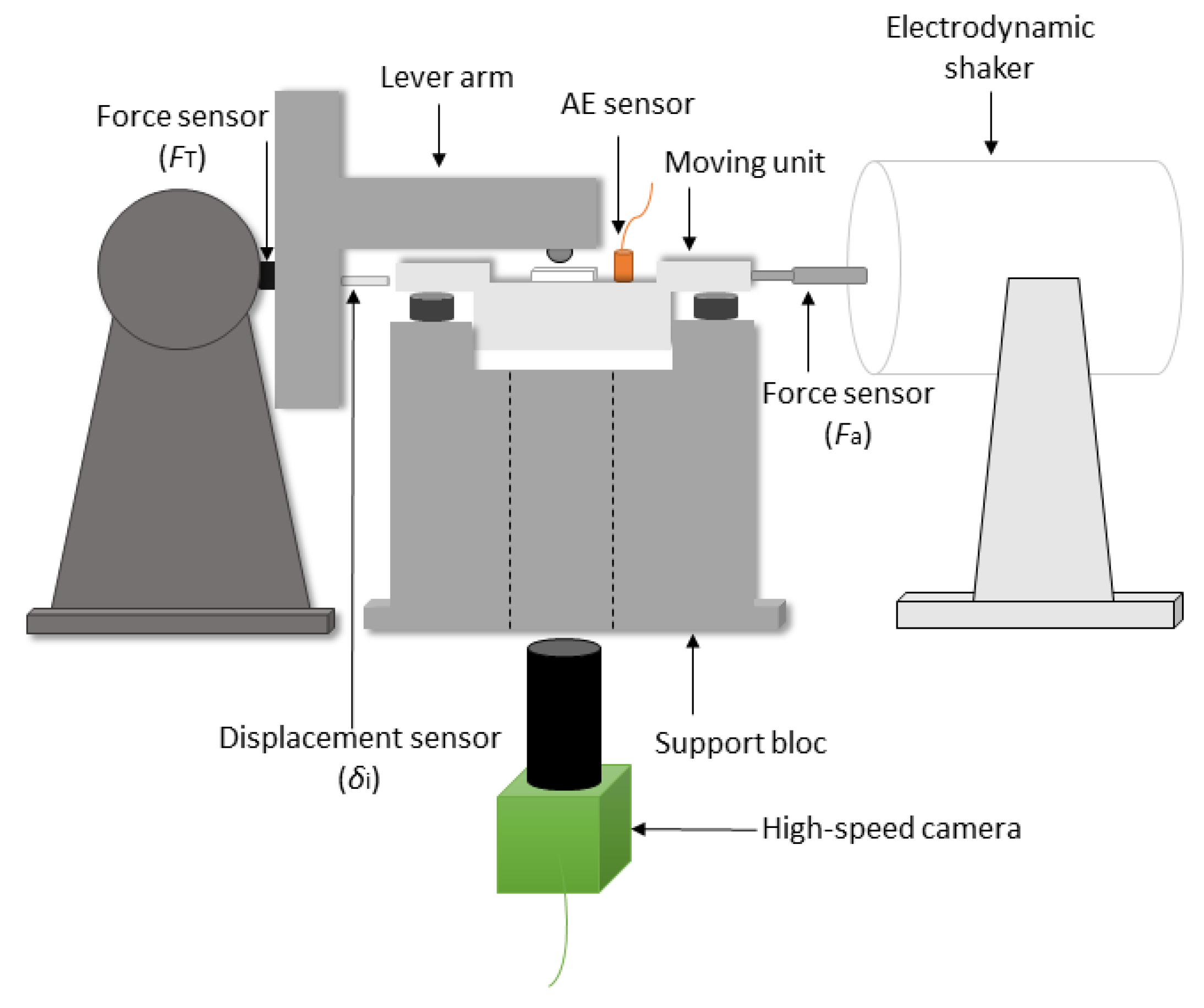

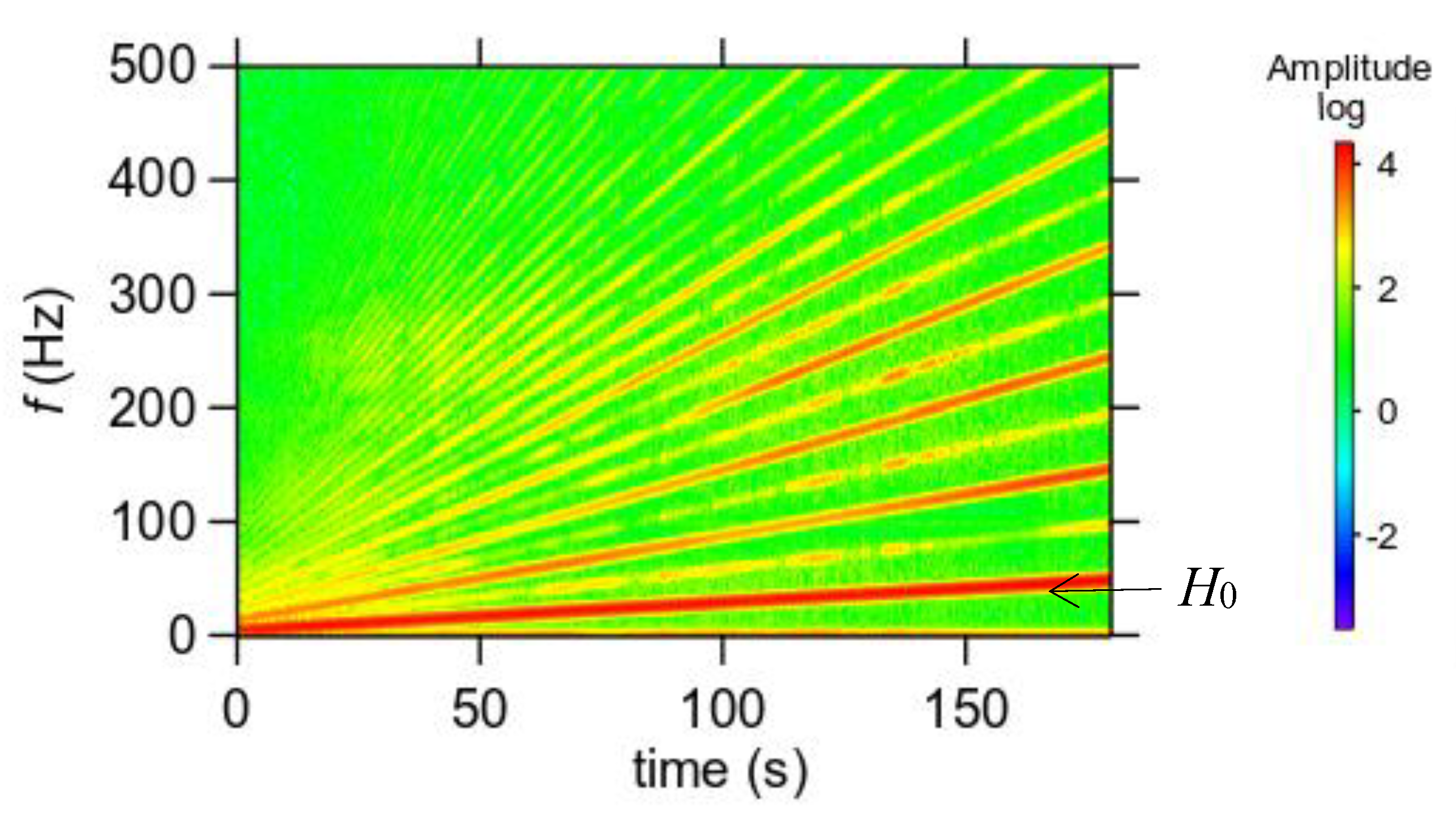


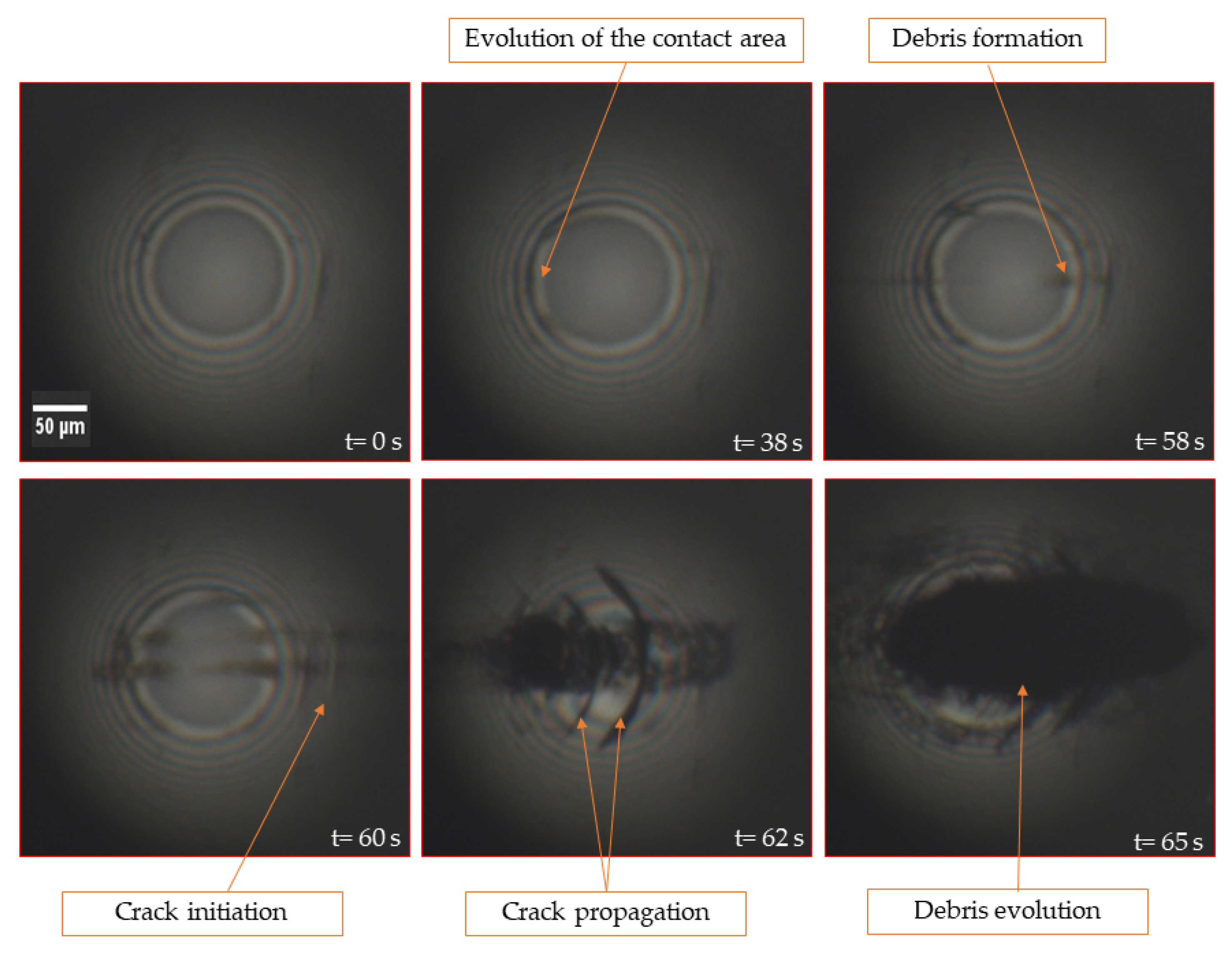
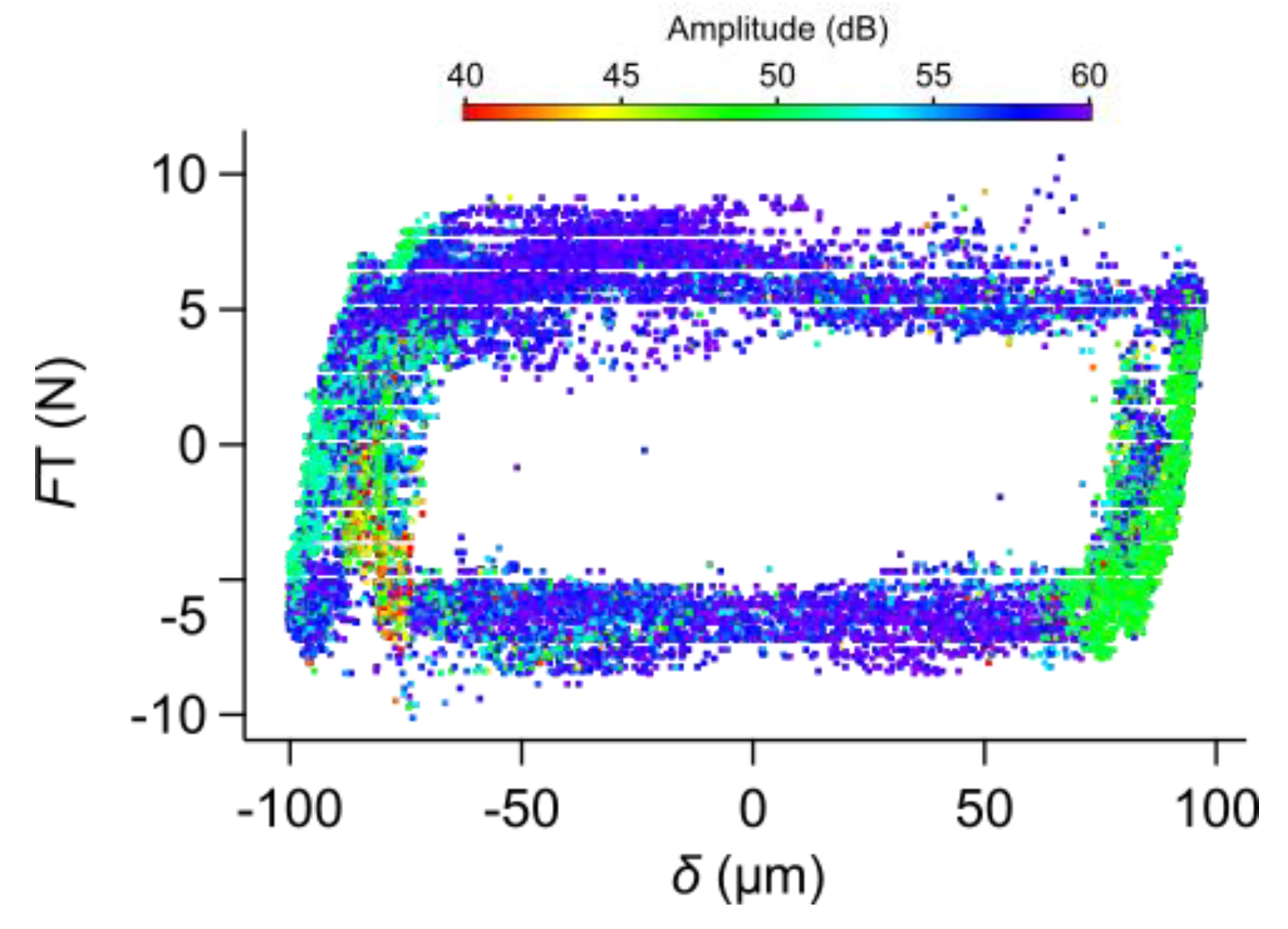
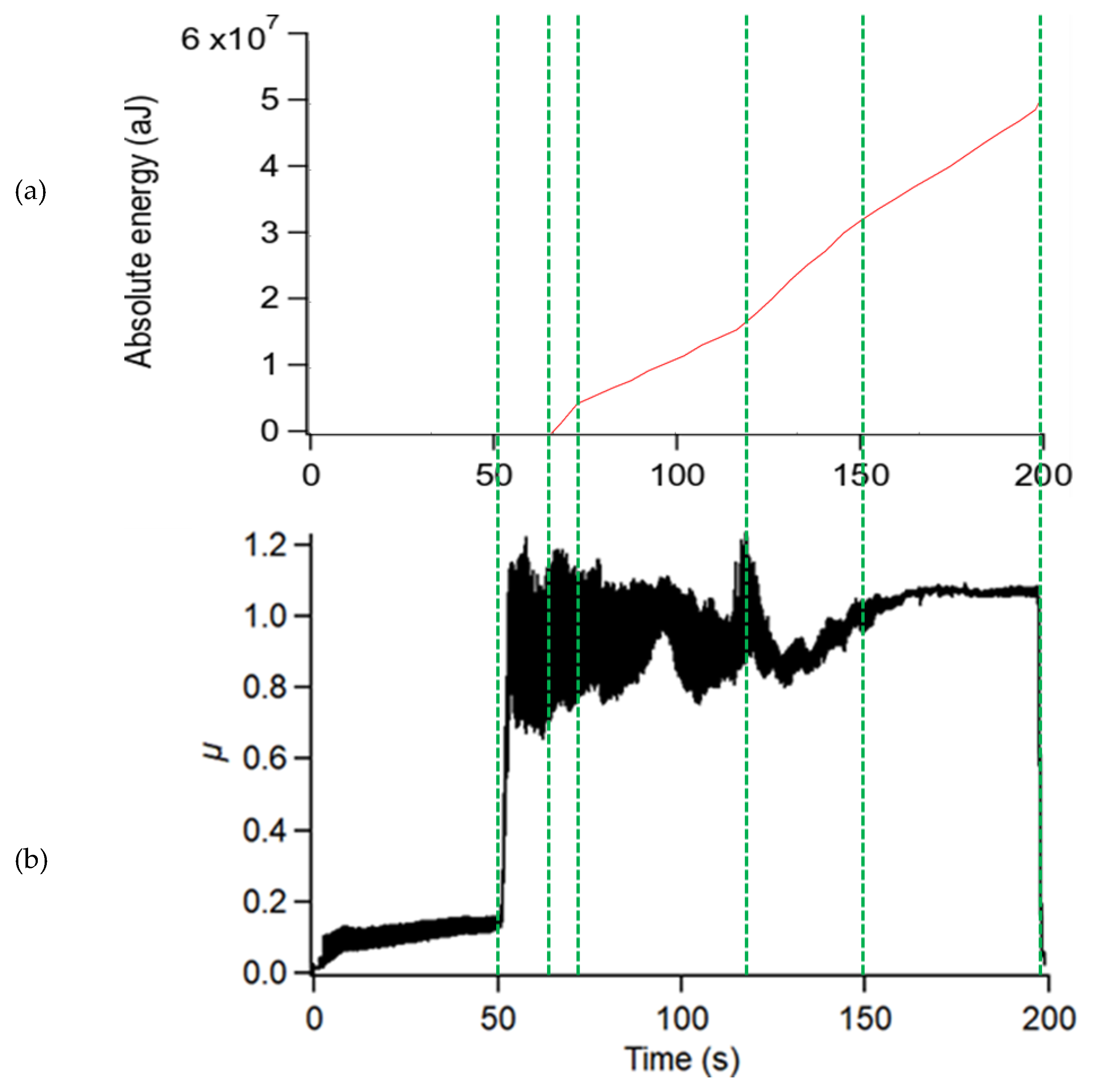
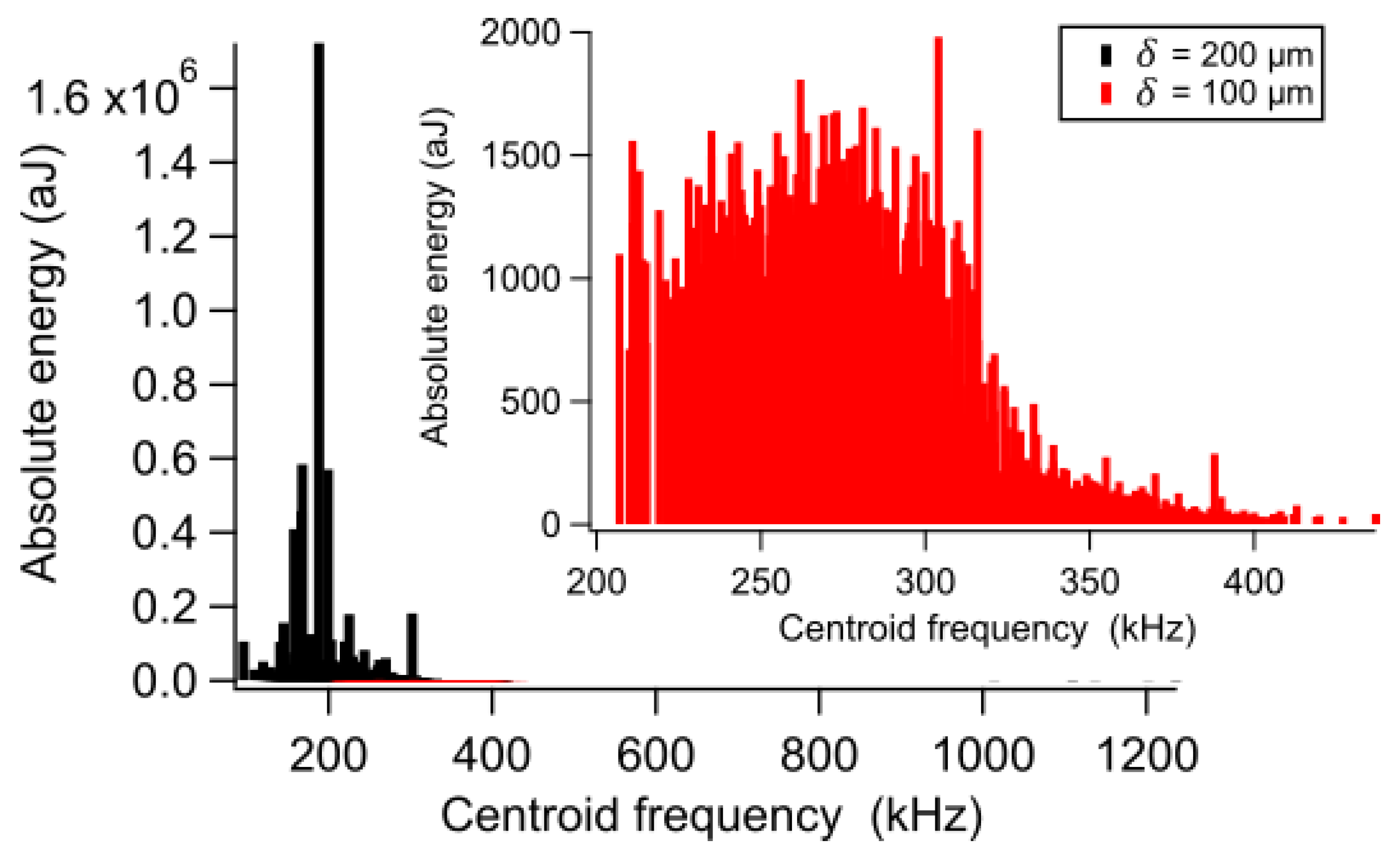
© 2020 by the authors. Licensee MDPI, Basel, Switzerland. This article is an open access article distributed under the terms and conditions of the Creative Commons Attribution (CC BY) license (http://creativecommons.org/licenses/by/4.0/).
Share and Cite
Jlaiel, K.; Yahiaoui, M.; Paris, J.-Y.; Denape, J. Tribolumen: A Tribometer for A Correlation Between AE Signals and Observation of Tribological Process in Real-Time—Application to A Dry Steel/Glass Reciprocating Sliding Contact. Lubricants 2020, 8, 47. https://doi.org/10.3390/lubricants8040047
Jlaiel K, Yahiaoui M, Paris J-Y, Denape J. Tribolumen: A Tribometer for A Correlation Between AE Signals and Observation of Tribological Process in Real-Time—Application to A Dry Steel/Glass Reciprocating Sliding Contact. Lubricants. 2020; 8(4):47. https://doi.org/10.3390/lubricants8040047
Chicago/Turabian StyleJlaiel, Khouloud, Malik Yahiaoui, Jean-Yves Paris, and Jean Denape. 2020. "Tribolumen: A Tribometer for A Correlation Between AE Signals and Observation of Tribological Process in Real-Time—Application to A Dry Steel/Glass Reciprocating Sliding Contact" Lubricants 8, no. 4: 47. https://doi.org/10.3390/lubricants8040047
APA StyleJlaiel, K., Yahiaoui, M., Paris, J.-Y., & Denape, J. (2020). Tribolumen: A Tribometer for A Correlation Between AE Signals and Observation of Tribological Process in Real-Time—Application to A Dry Steel/Glass Reciprocating Sliding Contact. Lubricants, 8(4), 47. https://doi.org/10.3390/lubricants8040047





